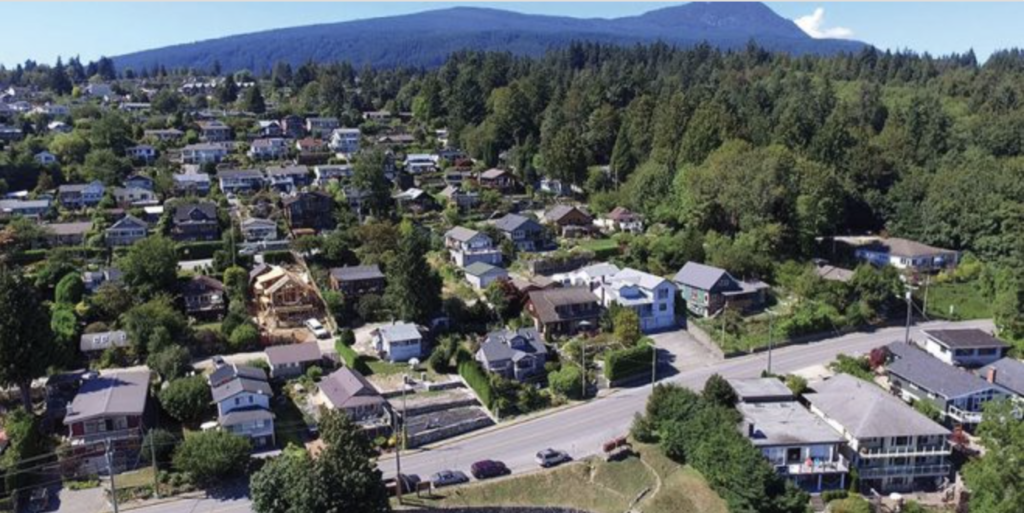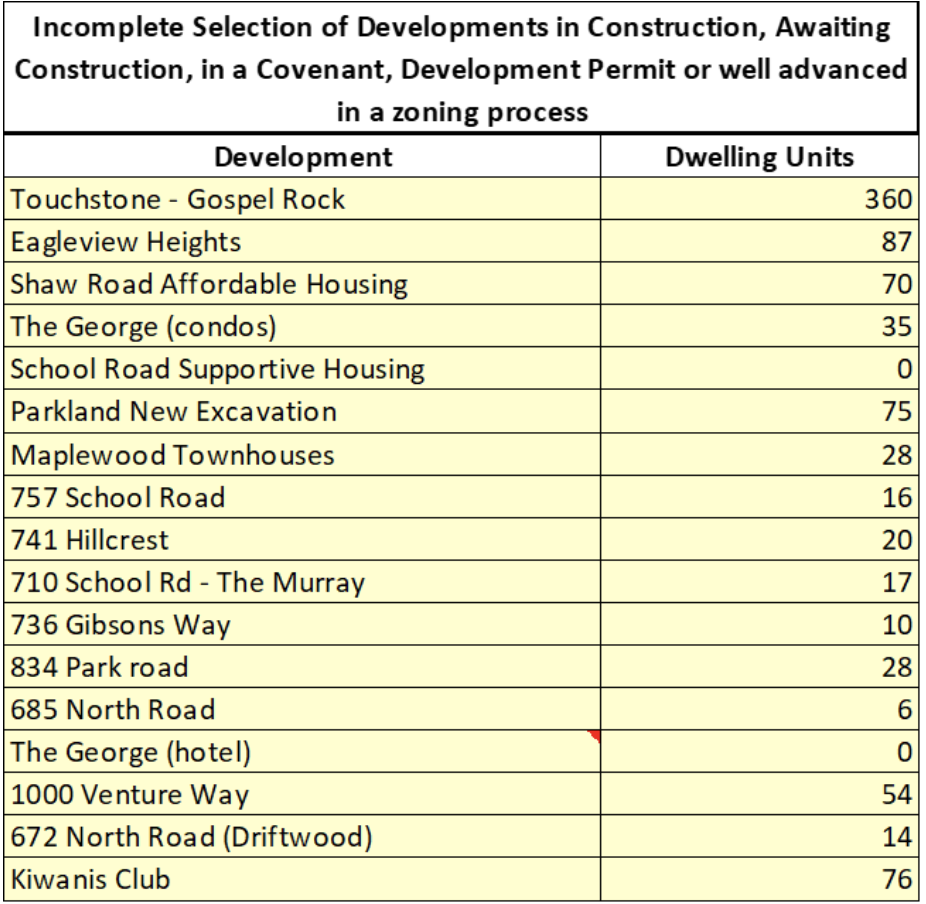
Town of Gibsons CAO Emanuel Machado dismissed Al Beaver’s findings but admitted the data on the Town’s website are incomplete
(BY NEWS DESK)
If the Gibsons aquifer can sustain a population of 10,000, as the Town says, then only 1,131 more housing units can be built in the Town.
Local consultant Al Beaver came to this conclusion using an international risk management standard.
But the density levels in the Official Community Plan (OCP) allow for another 3,322 units, for a total of 15,000 inhabitants.
“The density in the OCP in all zones needs to be reduced by 69 per cent,” Beaver told The Coast Clarion. “That’s political dynamite.
“But also think about the legal consequences. Suppose as a town you do nothing, and then people who bought really expensive properties just before the threshold is reached are told ‘Sorry, you can’t develop, we have no more water.’”
Beaver, 69, worked as manager of science, planning and policy for the Yukon government and was manager of planning and risk management for the state of Victoria in Australia. He currently has a consulting business in Gibsons called Wildland Fire Risk Management Ltd.
Beaver uses the ISO 31000 Risk Management Principles and Guidelines, codified by the International Organization for Standardization, which is the Canadian standard as well.
He based his analysis solely on data supplied by the Town. To his surprise, he found there is enough water in the aquifer to sustain a population of 10,370; the Town has put the number at 10,000. “I was pleased to see that,” he said. “They are being cautious.”
The Town included water for firefighting, commercial use and leakage in its assessment. “It also incorporated the possible need for more water for firefighting as the population increases, which is a good thing,” Beaver said.
The Town looked at the volume of water in the aquifer, based on the 2013 study by Waterline Resources Inc., and the consumption per person to reach its conclusion that the aquifer can sustain a population of 10,370.
“To take that one step further, I wondered: how many households is that?” Beaver said. “Urban Systems, one of the consultants the Town used, came up with an average household size of 2.3 persons in Gibsons. I used that.”
Beaver divided 10,370 inhabitants by 2.3 and found Gibsons has capacity for a total of 4,509 dwellings.
The latest census figures show 2,482 housing units in Gibsons, plus 896 in the pipeline:

According to StatsCan, 200 residential units in Gibsons are not permanently occupied. Beaver believes they must be included in the total number of dwellings. “Suppose in five years, they are all sold or occupied. We must make sure there is enough water to supply them in the future.”
Counting the number of current units and the ones in the queue, the Town has room for another 1,131 units, for perpetuity, Beaver said.
The Gospel Rock Neighbourhood Plan allows for 1,100 units, 31 shy of the remaining capacity of the aquifer. Of these, 360 are counted in the queue. The plans for Stonehurst envision 26 residences.
On the basis of the current OCP, a number of residences can be built on the lots next to Stonehurst and on the two former Seaglass lots across Marine Drive from the Black Bean. Development of the Shoal Bay properties is not in the queue yet either.
While the figure of 1,131 dwellings is based on a household size of 2.3, the average number of people in a household can change. For example, if more families with children move to Gibsons or the number of illegal suites increases, the number of people in a dwelling grows. With an increase in average household size to just 2.4, only 916 dwellings could be built and still be sustainable, Beaver found.

Gibsons needs affordable housing. According to the Sunshine Coast Housing Needs Report of November 2020, 16 per cent of owner households and 48 per cent of renter households on the Sunshine Coast were living in unaffordable housing in 2016, the latest figures available. The number is certainly higher now.
In his analysis, Beaver did not look at the value of housing units. “There is nothing wrong with building expensive dwellings, but you have to realize that once you’ve built the number of units the aquifer will sustain, you’re done. Buildings can be demolished and rebuilt, but it does not change the total number.”
The OCP dates back to 2015, and water use was not reconciled to carrying capacity of the aquifer, he said. “Had it been, it would not have had those density numbers.
“As it stands, the OCP allows for a number of units that would house about 15,000 people. What I’m saying is: adjust the OCP. Decreasing the number of dwellings per zone, all by the same percentage, would make it fair for all property owners.”
“It’s great that Gibsons is in the position to do something about it before it’s too late,” Beaver said. “The words ‘sustainable’ and ‘sustainability’ are in the OCP 69 times. Just do it. Bring in another consultant for a second opinion, or somebody else for a third opinion. But let’s get this right.”
The Coast Clarion asked Mayor Bill Beamish for comment on Beaver’s findings. “The Town relies on data that is the result of best practice and scientific study. The information you reference is not new,” he told The Coast Clarion.
“Our consultant, Waterline, is currently updating the 2013 Aquifer Study that generated the baseline numbers we use for the water-population balance, and which are constantly monitored. This updated information will be available shortly and any adjustments the Town makes to our planning projections will be based on that expertly developed information,” Beamish said in an email.
He attached a letter Chief Administrative Officer Emanuel Machado sent Al Beaver on December 17, 2020 after Beaver expressed his concerns about the capacity of the aquifer and the number of dwellings allowed in the OCP:
“Dear Mr. Beaver,
I am writing in response your submission of November 19, 2020, which makes unsubstantiated claims about the health of the Gibsons Aquifer. Town staff have reviewed the material you submitted and strongly disagree with your claims and statements, as they are incorrect and not supported by sufficient facts or real data. It needs to be recognized that, with the amount of data that we collect on the aquifer and the time it takes to put technical information into plain language, not all our data makes it on the website.
The information the Town collects, including an extensive annual monitoring program and ongoing updates of geotechnical information, shows a vastly different picture than the one you attempt to paint. Your comments were focused largely on the population projections/density and contained little, if anything, about per capita use or modelling of water use scenarios.
The Waterline 2013 report (available online) accounts for climate variability, sea level rise and responsible water management and is very conservative in its projections of available water. Moreover, the Town has reduced water consumption by more than half over the past 10 years which has had a significant impact on water level responses in the Gibsons Aquifer with reflect steady increases recorded ever since.
2020 data will be available soon. The Town’s Water Supply Strategy is also available online; both documents are planned to be updated with the most recent information that we have gathered.
The Town collects Groundwater Monitoring data and shares it with the province’s water licensing authorities, as required. That data shows that the applications of Development Permit #9 for Aquifer Protection have been effective in maintaining the water quality standards as well (i.e. groundwater chemistry is not impacted).
This development permit process is currently under review and further improvements, based on experiences to date, will be considered by Council in the near future. It should also be noted that the Ministry of Forests, Land, Natural Resource Operations and Rural is very aware of the Town’s work in groundwater management and has recognized the unusually advanced measures that the Town undertakes in the stewardship of this natural asset.
TOWN OF GIBSONS “Nature is our most valuable asset”
Lastly, we want to clarify that the information submitted and identified as a risk model, and later as a study, is not, in our opinion, scientific. It is based on incomplete information and lacks many of the requirements that would make it a valid study or model. The Town of Gibsons is staffed by highly qualified personnel who oversee our assets and engage other professionals where appropriate to ensure that we continue to respond to climatic changes, growth, and servicing the Town in the most responsible and informed manner.
More information can be found here: https://gibsons.ca/sustainability/the-gibsons-aquifer
In closing, I would like to thank you for continuing to stay engaged with the Town and contributing your ideas to community discussions. I would also like to ask that you are cautious about sharing your conclusions with others, as the data on which they are based is vastly incomplete and can cause concern or alarm where none is warranted.
Sincerely,
Emanuel Machado
Chief Administrative Officer
Town of Gibsons”
More information about the way Al Beaver reached his conclusions can be found here.
That is certainly sobering information. I hope the Town will adjust its housing projections once their own consultants confirm what Mr. Beaver is telling them. At least we are forewarned. As an aside, I’m wondering why Mayor Beamish released that letter from CAO Machado. It seems to address the health of the aquifer with a lot of bafflegab more than the problem of the capacity of the aquifer, and what was more concerning was the nasty tone with which Mr. Machado writes to a concerned (and knowledgeable) citizen. Since when do public servants do that?
Shocking information. I hope the Town will amend the OCP as soon as the new study from Waterline is in. I can’t imagine they will find that much extra water.
What is also shocking is Machado’s letter. If Beaver wrote him about the OCP density and the aquifer, as The Coast Clarion says, Machado either did not read his letter, did not understand it, or chose to pretend it was not about the density problem. All three options are bad.
And the tone! The disdain! The citizens of Gibsons pay Machado’s salary. I think at least he can try to be polite, civil and courteous.
It would seem that Mr. Beaver has only used simple math and applied it to the projections, i.e. water in divided by water out. Mr. Machado denigrates a citizen who has offered his time and expertise and offered what appears to me to be quite a reasonable argument that we are heading for a problem in the future with our water availability in Gibsons if we don’t be careful now.
It’s certainly evident in the tone of Machado’s letter that he regards Beaver as a threat rather than an asset. Too bad, is all I can say.
Shocking? Yes, indeed. Surprising? Not in the least. The reply from Machado is a veiled threat to not disclose this information. It speaks to misinformation and gaslighting. We know our water problems. Mr. Beaver knows his science and used the town’s own data. These are services that are supplied to the residents through a contract or agreement with local government. Taxes will surely rise. The outcome is inevitable regarding the present state of affairs and to keep loading the system at exponential rates is mind numbing.
Machado is burying his head in the sand. All the residents know what the truth is. Mr. Beaver is an educated professional who is donating his time to this problem- perhaps if he has incorrect information as Mr. Machado indicates in his response, he can provide the ‘correct’ information and data to Mr. Beaver. Perhaps Mr. Beaver can work with the ‘experts’ currently working for the town of Gibsons to make sure the numbers are correct. We can also see the challenges faced by our neighbouring communities due to a lack of water for their current population due to overdevelopment. In addition, when a community cannot water yards, there is a increased risk of fires. Climate change is another reality that will affect the amount of available water in the future. The town needs to take action now. We need to stop development of new, high end housing in favour of re-development of existing developed areas to provide affordable rental/housing(does that even exist here now) and create new models for housing. But that is another issue altogether. Again, we need to act now and revise the OCP.
A great article shedding clarity on a very confusing topic. I now understand the term carrying capacity for our aquifer and simple math shows us we cannot keep on spot zoning and approving big development at our present pace or we will clearly be out of water and have to look elsewhere for it not to mention that we are now sharing water with the SCRD. I also note that there is no accounting for all the water the 100 room George hotel will be consuming?
Machado’s dismissive letter speaks to other issues and does not cover the carrying capacity topic. The numbers are easy to understand but instead we will be spun narrative that paints a glowing picture of water consumption levels decreasing and all is under control. I guess that, there is no issue until the well runs dry…..
Looking elsewhere for water has been and will continue to be a topic. It should be addressed now to hopefully alleviate the problem for the future. The health of the community is at stake owing to unfettered development. There is no stopping the almighty dollar in regards to real estate and development. It seems that this region is a cookie jar with many hands in it.
Don’t be too hard on CAO Machado, it comes down to “practice what you preach”. “Build only what you must” or can in this case, and we can now define that.
“Restoring the ecological integrity of our natural assets, such as our watersheds, forests and wetlands, is crucial to our ability to withstand the impacts of an already changed climate,” said Emanuel Machado, CAO of the Town of Gibsons. “…The focus of our work is best summarized by a quote from a recent report by the Insurance Bureau of Canada and the Intact Centre on Climate Adaptation: Retain the natural assets that you have; Restore what you have lost; Build only what you must (Machado 2018).”